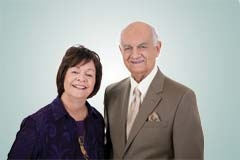Documentary Goes Down in History as Award Winner
The Broken Arrow Historical Society’s documentary film, “The History of Broken Arrow,” has won recognition by the Oklahoma Museums Association.
By: Betty Gerber | Category: In Our Communities | Issue: September 2011

Dr. Betty Gerber and Dr. Clarence Oliver. Photo courtesy of BOEBOI Photography
The Oklahoma Museums Association (OMA) has announced its annual list of museums to be recognized with awards to be presented in September at its annual conference. Recognition is being granted for the project’s success as an education program and its outreach.
Broken Arrow Historical Society is very pleased to be on the OMA award list this year for a documentary film the society produced with BOEBOI Photography, “The History of Broken Arrow.”
“The Broken Arrow Historical Society has made huge advances in every aspect of its programming and exhibits in recent years, and this documentary is an excellent example,” says Executive Director Dr. Betty Gerber.
Historical Society board member Dr. Clarence Oliver has for many years utilized a written script to share colorful local history with the annual Leadership Broken Arrow training seminar groups. His presentations have been so well received that the Historical Society Board decided to use Oliver’s script as the basis for a documentary video of Broken Arrow history.
A year ago, the Broken Arrow Historical Society Museum launched the video project by
contracting with a videographer, and Executive Director Betty Gerber began adapting the script for use in the documentary project. She also selected photographs from the museum collection and enlisted 18 local residents to interview for specific areas of expertise or knowledge.
Interviewees included descendants of pioneer families from Tennessee and Arkansas. Their attraction to Indian Territory was explained as a part of Westward Expansion, but their anecdotes were personal stories. The story of the proposed State of Sequoyah as well as Coweta County with Broken Arrow as the county seat was also shared, along with stories of coal mining, agriculture, the Rooster Day celebration and the evolution of the city into the third largest manufacturing center in Oklahoma.
Oliver and Gerber narrate the piece, and the pioneer stories and interviews are woven together to tell a story, not just of local history, but a story that is representative of larger area of what was once Indian Territory: territorial explorations, the Creek tribal town, the first railroads of Oklahoma, statehood, coal mining, agriculture, the Great Depression, early industry, roads and highway development, and more.
Most of the historical society’s collection of over 1,200 photos appears in the video as they relate to stories being told.
Native American actors portrayed the Broken Arrow band of Creek Indians who settled here in 1828 and were on hand to greet Washington Irving in 1832 as part of the Ellsworth exploration party. The Creek Nation master bow maker Mike Berryhill appears in the video to explain the traditional Creek process of making arrows and how the tribal town of Broken Arrow came to be named for the breaking of river cane to make arrows.
The video project required seven months to complete. The result is a 90-minute video divided into multiple “chapters” to facilitate classroom use. During production, the historical society acquired donations to sponsor the project, raising 50 percent of the total cost. Once the project was completed, a community premiere showing of the video was held at the Broken Arrow Schools new Performing Arts Center to a crowd of over 500 people.
“Since the opening of the Broken Arrow Historical Society’s new museum in 2009, we have hosted art exhibits, an exhibit of tribal art, a photography exhibit, an historical bus tour,
several public events, and we have greatly expanded our outreach to the public schools. This documentary furthers our educational outreach,” adds Gerber, “and that is what we are all about.”
Following the premiere, complimentary copies were distributed to the public schools in Broken Arrow, with a potential audience of 16,000. The Historical Society expects that the number served will continue to expand over time and offers the documentary for sale in its gift shop at 400 S. Main in Broken Arrow.
For more information, contact
Broken Arrow Historical Society
400 S. Main St.Broken Arrow, OK 74012
(918) 258-2616
www.bahistoricalsociety.com
Broken Arrow Historical Society Museum
For more information, contact:
Broken Arrow Historical Society Museum
eat0@eau0eav0eaw0
More about Broken Arrow Historical Society Museum:
More ArticlesSubscribe
For Free!
